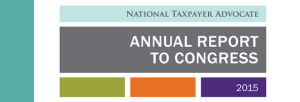by | ARTICLES, BLOG, BUSINESS, FREEDOM, GOVERNMENT, OBAMA, POLITICS, TAX TIPS, TAXES

My friend, Nina Olson, has been the long-time Taxpayer Advocate (TA) for the IRS, an independent office within the IRS. The job of the TA is to ensure that every taxpayer is treated fairly and that every taxpayer knows and understand his or her rights. Each year, the TA issues two different reports to Congress. Today, the TA released her 2015 Annual Report to Congress, with a list of the twenty most serious problems facing the IRS today.
Think reaching a human at the Internal Revenue Service last tax filing season was tough? Olson anticipates even less telephone and face-to-face customer service in future years. A planned expansion of IRS online offerings will leave taxpayers who seek help the old-fashioned way “up a creek,” listing it as the No. 1 problem in a report to Congress released Wednesday.”
An overview from Bloomberg noted another serious problem: transparency. “Since 2014 the IRS has spent “several million dollars” working with management consultants to develop a plan for how it will operate over the next five years. The details in the report haven’t been made public or shared with Congress, and the IRS hasn’t solicited comments from a broad pool of constituents, the advocate’s report notes.
Additionally, the IRS has never asserted so many times that data and documents the Taxpayer Advocate planned to include were for “official use only” and couldn’t be made public. That made this year’s report difficult to write, Olson says, “because while the intent to reduce telephone and face-to-face service has been a central assumption in the five-year ‘Future State’ planning process, little about service reductions has been committed to writing.”
Olson is calling for congressional hearings on the IRS plan over the next few months, and will solicit comments at public hearings held across the country. Among groups she plans to invite are those with the greatest need for free help, including the elderly, the disabled, small businesses, low-income taxpayers, and people with limited English proficiency.
The impression the Taxpayer Advocate’s office has, based on discussions with IRS officials, is that the agency’s ultimate goal is “to get out of the business of talking with taxpayers.” It would do that in part by creating online accounts for filers, which Olson sees as a good way to supplement, not replace, existing service—as long as data security concerns are addressed.
While far more people file electronically now, and the IRS has taken many steps to limit the need for taxpayers to phone the IRS, the demand for personal service hasn’t decreased. In fact, over the past decade the number of calls the IRS received on its Accounts Management lines rose from about 64 million for fiscal year 2006 to about 102 million for fiscal year 2015. That’s almost a 60 percent jump. Automating customer service even more, the report says, “will mean only those with the means to pay for it can receive help with their taxes.”
Here are Nina’s Top Twenty Problems:
TAXPAYER SERVICE: The IRS Has Developed a Comprehensive “Future State” Plan That Aims to Transform the Way It Interacts With Taxpayers, But Its Plan May Leave Critical Taxpayer Needs and Preferences Unmet
IRS USER FEES: The IRS May Adopt User Fees to Fill Funding Gaps Without Fully Considering Taxpayer Burden and the Impact on Voluntary Compliance
FORM 1023-EZ: Recognition As a Tax-Exempt Organization Is Now Virtually Automatic for Most Applicants, Which Invites Noncompliance, Diverts Tax Dollars and Taxpayer Donations, and Harms Organizations Later Determined to be Taxable
REVENUE PROTECTION: Hundreds of Thousands of Taxpayers File Legitimate Tax Returns That Are Incorrectly Flagged and Experience Substantial Delays in Receiving Their Refunds Because of an Increasing Rate of “False Positives” Within the IRS’s Pre-Refund Wage Verification Program
TAXPAYER ACCESS TO ONLINE ACCOUNT SYSTEM: As the IRS Develops an Online Account System, It May Do Less to Address the Service Needs of Taxpayers Who Wish to Speak with an IRS Employee Due to Preference or Lack of Internet Access or Who Have Issues That Are Not Conducive to Resolution Online
PREPARER ACCESS TO ONLINE ACCOUNTS: Granting Uncredentialed Preparers Access to an Online Taxpayer Account System Could Create Security Risks and Harm Taxpayers
INTERNATIONAL TAXPAYER SERVICE: The IRS’s Strategy for Service on Demand Fails to Compensate for the Closure of International Tax Attaché Offices and Does Not Sufficiently Address the Unique Needs of International Taxpayers
APPEALS: The Appeals Judicial Approach and Culture Project Is Reducing the Quality and Extent of Substantive Administrative Appeals Available to Taxpayers
COLLECTION APPEALS PROGRAM (CAP): The CAP Provides Inadequate Review and Insufficient Protections for Taxpayers Facing Collection Actions
LEVIES ON ASSETS IN RETIREMENT ACCOUNTS: Current IRS Guidance Regarding the Levy of Retirement Accounts Does Not Adequately Protect Taxpayer Rights and Conflicts with Retirement Security Public Policy
NOTICES OF FEDERAL TAX LIEN (NFTL): The IRS Files Most NFTLs Based on Arbitrary Dollar Thresholds Rather Than on a Thorough Analysis of a Taxpayer’s Financial Circumstances and the Impact on Future Compliance and Overall Revenue Collection
THIRD PARTY CONTACTS: IRS Third Party Contact Procedures Do Not Follow the Law and May Unnecessarily Damage Taxpayers’ Businesses and Reputations
WHISTLEBLOWER PROGRAM: The IRS Whistleblower Program Does Not Meet Whistleblowers’ Need for Information During Lengthy Processing Times and Does Not Sufficiently Protect Taxpayers’ Confidential Information From Re-Disclosure by Whistleblowers
AFFORDABLE CARE ACT (ACA) – BUSINESS: The IRS Faces Challenges in Implementing the Employer Provisions of the ACA While Protecting Taxpayer Rights and Minimizing Burden
AFFORDABLE CARE ACT (ACA) – INDIVIDUALS: The IRS Is Compromising Taxpayer Rights As It Continues to Administer the Premium Tax Credit and Individual Shared Responsibility Payment Provisions
IDENTITY THEFT (IDT): The IRS’s Procedures for Assisting Victims of IDT, While Improved, Still Impose Excessive Burden and Delay Refunds for Too Long
AUTOMATED SUBSTITUTE FOR RETURN (ASFR) PROGRAM: Current Selection Criteria for Cases in the ASFR Program Create Rework and Impose Undue Taxpayer Burden
INDIVIDUAL TAXPAYER IDENTIFICATION NUMBERS (ITINs): IRS Processes Create Barriers to Filing and Paying for Taxpayers Who Cannot Obtain Social Security Numbers
PRACTITIONER SERVICES: Reductions in the Practitioner Priority Service Phone Line Staffing and Other Services Burden Practitioners and the IRS
IRS COLLECTION EFFECTIVENESS: The IRS’s Failure to Accurately Input Designated Payment Codes for All Payments Compromises Its Ability to Evaluate Which Actions Are Most Effective in Generating Payments
EXEMPT ORGANIZATIONS (EOs): The IRS’s Delay in Updating Publicly Available Lists of EOs Harms Reinstated Organizations and Misleads Taxpayers
EARNED INCOME TAX CREDIT (EITC): The IRS Does Not Do Enough Taxpayer Education in the Pre-Filing Environment to Improve EITC Compliance and Should Establish a Telephone Helpline Dedicated to Answering Pre-Filing Questions From Low Income Taxpayers About Their EITC Eligibility
EARNED INCOME TAX CREDIT (EITC): The IRS Is Not Adequately Using the EITC Examination Process As an Educational Tool and Is Not Auditing Returns With the Greatest Indirect Potential for Improving EITC Compliance
EARNED INCOME TAX CREDIT (EITC): The IRS’s EITC Return Preparer Strategy Does Not Adequately Address the Role of Preparers in EITC Noncompliance.
You can read the report in full by going here.
by | ARTICLES, BLOG, BUSINESS, ECONOMY, FREEDOM, GOVERNMENT, POLITICS, TAXES

In 2015, the federal government’s published 82,036 pages of rules, proposed rules and notices. It surpassed last year’s 77,687 pages broke the previous record of 81,405 pages in 2010. Competitive Enterprise Institute issued their yearly survey of the federal regulatory state. Among them are some of their findings:
*3,378 final rules and regulations were created
*2,334 proposed rules were issued in 2015 and are at various stages of consideration.
*29 executive orders and 31 executive memorandums were issued
Regulation functions as a hidden tax. Last year’s report calculated that, “based on the best available federal government data, past reports, and contemporary studies, regulatory compliance costs $1.88 trillion annually.”
Recommendations for reigning in regulation include repealing “certain statutes, require congressional approval for big rules and enforce maximum requirements set forth in the Administrative Procedure Act.” 2015 saw major final rules from the EPA — the Clean Power Plan and its Waters of the Unites States rule — as well as the FCC’s net neutrality order.
You can follow updates on federal regulation on CEI’s “Ten Thousand Commandments” page here
by | ARTICLES, BUSINESS, FREEDOM, GOVERNMENT, OBAMA, POLITICS, TAXES

Earlier in December, the EPA published a document referencing the Gold King Mine disaster, saying that they intended to “clarify any misunderstandings about the incident.” The EPA had “recently interviewed two material witnesses to the EPA’s activities at Gold King Mine” and subsequently published its own narrative of the event.
The problem arises because the Office of Inspector General is conducting an ongoing investigation into how the EPA handled the toxic spill in Colorado, at the hand of federal workers. Some of the concerns raised by lawmakers include:
- “The timing of the interview calls into question the EPA’s respect for the OIG’s ongoing investigation and commitment to ensuring the integrity of witness testimony.”
- “The EPA’s own guidance states that ‘managers should not question staff about their interactions with the OIG.’”
- “It appears likely that a regional supervisor and two officials from headquarters questioned [the on-scene coordinators] about matters central to an ongoing OIG investigation, and may have done so following their interactions with the OIG.”
- “The interview was conducted not by independent investigators or technical experts from unaffected regions, but by three EPA employees with close ties to the agency’s public response to the Gold King Mine spill.”
What’s more, lawmakers claim that the EPA is suggesting they had planned to open the mine on August 14 — nine days after the mine spill actually occurred, and that their claim is demonstrably false and is one of multiple claims that diverge from the facts and conclusions presented in reports issued previously by EPA and the Interior Department.
The EPA caused a serious and utterly avoidable toxic spill into our rivers. The federal workers involved in this environmental disaster deserve to be prosecuted to the fullest — or at least the very same punishments the EPA seeks to impose on everyday citizens in America. And if, for any reason, EPA personnel are to be given special treatment as compared to private industry, that decision…..and the reasons for it….must be justified to the American people.
You can read more on the investigation from The Daily Caller
by | ARTICLES, BLOG, BUSINESS, ECONOMY, FREEDOM, OBAMA, OBAMACARE, POLITICS, TAXES

With the insurance enrollment period ending in mid-December, Healthcare.gov announced that 8.2 million Americans selected plans for 2016 in 38 states. The Administration is touting the 8.2 figure as a “success” by comparing it to the 6 million plan selections by the same time last year. There was no mention, however, of how the 8.2 million number falls exceedingly short of the 21 million projected to be Obamacare users.
One amusing point is how the Administration parsed its words. “Plan selection” is an important phrase in Obamacare-speak. It means that many people chose these plans, filled out the forms, and submitted them — but did not necessarily pay for them. This is why they didn’t use the term “enroll” when describing the Obamacare figures. In order to be considered to be actually enrolled, one must pay the first month’s premium. Not everyone will actually go ahead and pay their premium, and the federal Obamacare numbers will inevitably be even smaller because of it.
The current figure excludes the state insurance exchanges. When these are added to the federal numbers, the Obama Administration is hoping that will get them over the 10 million mark for this year — half of what was touted when Obamacare was passed. If they do hit that number, it still means that only about a million people were added to Obamacare this year, as last year’s enrollment ended up being about 9.1 million users.
In the debates leading up to Obamacare, it was argued that Obamacare should be voted for because it would get eventually get 28 million of the uninsured 45 million Americans (15% of the 315 million population). At that projected target, the 28 million would only be covering 70% of the then-uninsured, which is decent but not excellent. It is clear now that NOBODY would have voted for Obamacare if they only expected to cover 10 million (or barely more than 20%) of the then-uninsured, which is where we currently are. That is the key, salient point that is now being lost in the discussions.
The ACA continues to be a disaster for all taxpayers.
by | ARTICLES, BLOG, BUSINESS, ECONOMY, GOVERNMENT, OBAMA, POLITICS, TAXES

On a recent post over at Cafe Hayek, my friend Don Boudreaux discusses the merits of minimum wage policy. A gentleman, Mr. Hutcheson, wrote in to chide the writers, saying that Boudreaux and others “who argue that the minimum wage destroys some jobs miss the point.” Mr. Hutchinson insisted that the real point is “the amount of harm to low income workers compared to the benefits of going to other low-income workers.”
Boudreaux correctly responded that minimum wage legislation is unethical because the government strips “some people of economic opportunity in order to artificially enhance the opportunities available to other people.”
Although Don’s response is certainly correct, I do not believe arguments of fairness, morals, or constitutionality carry much weight with the standard liberal position espoused by Mr. Hutcheson. I believe that he needs to understand that raising the minimum wage hurts everyone, as other individuals and the economy as a whole are outright harmed by such policy by much more than than those who are helped. This can be seen by realizing that the money that is now going to a higher minimum wage WILL NECESSARILY cause one or a combination of the following:
1) In an attempt to offset the higher minimum wage, the business will fire or refuse to hire other employees. Especially from the poorest among us, many individuals. will either lose their job or not be able to get jobs at all moving forward. The cost of raising the minimum wage is just like the cost of raising a commodity. For instance, consider the scenario where the price of apples — a basic pantry item for most everybody — goes from $1.50/pound to $2.00/pound. Fewer people will buy the apples, or people will buy fewer apples overall. So it is also with a higher minimum wage; if a unit of labor costs more,fewer units of labor will be purchased overall. As a result, the economy will likely contract because of the loss of jobs resulting from a wage hike.
2) The business can simply earn less profit. If more of the earnings must go to the cost of labor, the business earns less profit overall. For some minimum wage advocates, perhaps that is the actual goal — to keep businesses from earning too much at the top. But in reality, the loss of business capital (from both large corporations to small mom and pops) means there is less money to grow the existing business, or for future business endeavors. Whether it is reinvested directly back into the business with equipment upgrades or growing the business through new employees or expansion, earning less money for the company creates a ripple effect. The less a company can earn, the less it can help grow the economy. Impeding its ability to do so, through the imposition of mandated wage increases, is harmful.
3) In order to offset the increased wage cost, a business, if possible, can choose to raise its prices. This will attempt to ensure that the company earns the same amount as before. But the effect of the price increase is negative. As prices increase, supply and demand dictates that some customers will simply not buy (reducing GDP) and the rest will have their standard of living go down (because they are paying more just to have the same product as before).
Every one of these responses — cutting jobs, loss of business capital, and raising prices — are bad for the employees and the economy as a whole. Though the minimum wage hikes sound good in theory, in reality, economies don’t exist in a vacuum. These types of policies hurt more than help. The three aforementioned points overwhelm anything positive going to minimum wage recipients; in reality, it is a bigger net cost to the system.
Would ⅔ of the population still support the minimum wage it if they understood how devastating it would be both to the most economically disadvantaged people and to the economy as a whole? People have continuously been pitched the false idea that the economy improves because minimum wage recipients will spend their extra money. Minimum wage policy is an impediment. Economics 101 reminds us that in fact, it is more stimulative for the economy that the employer keep the money and reinvest it than for the worker to merely spend it. That is how you grow the economy.
by | ARTICLES, BLOG, BUSINESS, GOVERNMENT, HYPOCRISY, OBAMA, POLITICS, TAXES

The Government Accounting Office (GAO) concluded that the EPA violated federal law and participated in “covert propaganda” through social media in order to encourage passage of Obama’s new and controversial “Clean Water Rule.”
From the report:
“The use of appropriated funds associated with implementing EPA’s Thunderclap campaign and establishing hyperlinks to the NRDC and to the Surfrider Foundation webpages violated prohibitions against publicity or propaganda and grassroots lobbying contained in appropriations acts for FYs 2014 and 2015. Because EPA obligated and expended appropriated funds in violation of specific prohibitions, we also conclude that EPA violated the Antideficiency Act, 31 U.S.C. § 1341(a)(1)(A), as the agency’s appropriations were not available for these prohibited purposes.”
This is not the first time this year that the EPA has not followed law. Don’t forget, in July, the EPA “was accused of colluding with left wing environmental groups to push its new carbon regulations.” A month later, “the EPA was responsible for a toxic spill at an abandoned mine that polluted rivers in three states.” And in October, “a federal appeals court said the EPA broke the law when it illegally approved a pesticide.”
Let’s hope that the Clean Water Rule does not come to fruition.
by | ARTICLES, BLOG, BUSINESS, CONSTITUTION, ECONOMY, OBAMA, OBAMACARE, POLITICS, TAX TIPS, TAXES

The Wall Street Journal put together an excellent editorial yesterday on the intersection of Obamacare and immigration.
First, starting in 2016, employers with 50 or more full time employees are required to offer health insurance for each of their workers, or else pay a penalty of $3,000 per each person who fails to receive proper Obamacare coverage.
So what happens with the undocumented immigrants allowed to stay under President Obama’s Executive Action? The numbers are estimated to be upwards of 5 million people.
“The government’s petition says that the executive action intended to provide ‘work authorizations’ so that undocumented immigrants could find jobs in the U.S. without working illegally for less than market wages, which might harm American workers. But wait: Employers aren’t required to offer ObamaCare coverage or subsidies to these immigrants. The statutory language in the Affordable Care Act says that only ‘lawful residents’ are eligible, and the government’s petition specifically notes that the immigration action does not ‘confer any form of legal status in this country.'”
Therefore, the immigrants (with deferred deportation), are exempt from Obamacare. While that may be good for the taxpayer, it is not necessarily good news for the worker. From a purely financial perspective, companies could easily save the $3000 penalty cost per worker if they hire and employ an Obamacare-exempt immigrant instead of a citizen/resident subject to the Obamacare rules.
The Wall Street Journal sums up the scenario nicely:
“Suppose businesses subject to ObamaCare employ only 40%, or two million, of the up to five million immigrants covered by the president’s executive action. At $3,000 an employee, businesses would save about $6 billion a year. Companies already dealing with the added expense of operating in the Obama economy — burdened by regulations, high taxes and other barnacles — would find those savings hard to pass up.”
Exempting employers who hire these immigrants from the law’s penalties gives the immigrants a distinct market advantage over U.S. citizens. That flies in the face of the president’s statement that his executive action would not “stick it to the middle class” by allowing these individuals to “take our jobs.” It is also contrary to the government’s statement that the executive action would make it less likely that these undocumented immigrants hurt American workers by “illegally” working “for below market rates.” They could still work at below-market rates, only it would be legal.
All of this was inevitable. The root problem with ObamaCare is that one party rammed it through Congress without a single Republican vote, while the law’s supporters didn’t even read it, let alone vet it through congressional committees. As a result, ObamaCare as written was unworkable, and the administration has had to repeatedly amend it by constitutionally dubious executive fiat.
Now this flawed law is clashing with yet another constitutionally dubious executive action that the administration couldn’t be bothered to pass through the legislature.”
The Obama Administration may yet decide to grant Obamacare to these immigrants currently exempted. But for the time being, since their status presents a situation may wreak havoc in the business world, leaving the current court injunction against the immigration order in place is the only suitable solution until the Obamacare-immigration situation is sorted out. Otherwise, expect the economy to continue to weaken from this latest threat.
by | ARTICLES, BLOG, BUSINESS, ECONOMY, GOVERNMENT, OBAMA, POLITICS, TAXES

As has been earlier reported here, the debt ceiling jumped dramatically the day after the debt ceiling was lifted on November 2nd ($339 billion) and continued to soar all month.
By the end of the month, the debt had doubled, adding another $335 billion. All in all, $674 billion in US debt had accumulated, making the total US debt a staggering $18.827 trillion.
Also noted by Zerohedge, the debt was $10.6 trillion on January 21, 2009, on the day President Obama took office. The total debt is now up just over 77% under Obama’s tenure, to $18.8 trillion.
by | ARTICLES, BLOG, BUSINESS, ECONOMY, FREEDOM, GOVERNMENT, OBAMA, OBAMACARE, POLITICS, TAXES

Last week, UnitedHealth, one of the biggest insurers in the United States, announced that it would cease a good amount of healthcare marketing in 2016 as it ponders whether or not to stay in the exchanges for 2017 and beyond. Now, the CEO has come out and stated that UnitedHealth should have waited longer before joining Obamacare.
From Bloomberg:
UnitedHealth Group Inc. should have stayed out of Obamacare’s new individual markets longer, the chief executive officer of the biggest U.S. health insurer said Tuesday, after announcing last month that it will take hundreds of millions of dollars in losses related to the business.
While the company’s other lines of business are growing, instead of expanding into Obamacare next year, the company should have kept waiting, UnitedHealth CEO Stephen Hemsley said at an investor meeting in New York.
“It was for us a bad decision,” Hemsley said. “I take accountability for sitting out the exchange market in year one so we could in theory observe, learn and see how the market experience would develop. This was a prudent going-in position. In retrospect, we should have stayed out longer.”
UnitedHealth said on Nov. 19 that it may quit selling coverage in the Affordable Care Act’s individual markets in 2017. The markets are a key element of the law’s goal to cover about 10 million Americans next year, and UnitedHealth had expanded its offerings for 2016, after initially holding off when the markets started covering people in 2014.
Losses from the plans this year and next will total more than half a billion dollars, the company has said, and UnitedHealth will scale back efforts to market coverage to millions of people shopping for 2016 insurance on the Affordable Care Act’s new marketplaces.
UnitedHealth is not alone in its Obamacare struggles. Other insurers, including competitors Anthem Inc. and Aetna Inc., have also either suffered losses in the markets or said they haven’t seen the margins they expected. Next year will be the law’s third of providing coverage.
“It will take more than a season or two for this market to develop,” Hemsley said. “We did not believe it would form this slowly, be this porous, or become this severe.”
Hemsley said today that the rest of UnitedHealth’s businesses are faring better than its comparatively small exchange operation, which it has said covers about 540,000 people. The company said it expects operating earnings of $13.1 billion to $13.5 billion next year, on revenue of $180 billion to $181 billion.
UnitedHealth advanced 1.7 percent to $114.59 at 10:01 a.m. in New York. The stock has gained 11 percent this year, as of Monday’s close.
Enrollment at the company’s insurance businesses will climb to 47.4 million to 48.2 million people next year, from 46.2 million at the end of 2015. The company is projecting more enrollees in line of business including Medicare Advantage and Medicaid. Separately, UnitedHealth said its drug-coverage business for the elderly, Medicare Part D, may lose as many as 650,000 customers.
Across all of its insurance businesses, UnitedHealth said it expects to spend about 81.5 cents of every dollar it takes in from premiums on medical expenses.
by | ARTICLES, BLOG, BUSINESS, FREEDOM, GOVERNMENT, OBAMA, POLITICS, TAXES

On Friday, Republicans Overseas Action, Inc. filed a 78-page Plaintiffs’ Motion for Leave to Amended Complaint against the Foreign Account Tax Compliance Act (FATCA), the intergovernmental agreements (IGAs), and the Report of Foreign Bank and Financial Accounts (FBAR) in the U.S. District Court for the Southern District of Ohio, on behalf of Senator Rand Paul and nine other co-plaintiffs.
The then plaintiffs include “U.S. citizens, former U.S. citizens, Republicans, and/or non-Republicans” who are willing “to defend 8.7 million overseas Americans and 12.6 million stateside “green card” holders in their fight against FATCA tyranny.”
“The U.S. Treasury, IRS, and U.S. Financial Crimes Enforcement Network (FCEN) are still named as Defendants in this amended verified complaint for declaratory and injunctive relief with eight-count of constitutional violations:
Count 1 – The IGAs are Unconstitutional Sole Executive Agreements Because They Exceed the Scope of the President’s Independent Constitutional Powers
Count 2 – The IGAs are Unconstitutional Sole Executive Agreements Because They Override FATCA
Count 3 – The Heightened Reporting Requirements for Foreign Financial Accounts Deny U.S. Citizens Living Abroad the Equal Protection of the Laws
Count 4 – The FATCA FFI Penalty is Unconstitutional under the Excessive Fines Clause
Count 5 – The FATCA Pass-through Penalty is Unconstitutional under the Excessive Fines Clause
Count 6 – The FBAR Willfulness Penalty is Unconstitutional under the Excessive Fines Clause
Count 7 – FATCA’s Information Reporting Requirements are Unconstitutional under the Fourth Amendment
Count 8 – The IGAs’ Information Reporting Requirements are Unconstitutional under the Fourth Amendment”
Now, the relevance.
“In 2010, Congress passed FATCA, which was enacted as a means to find foreign accounts of US taxpayers (such as a Swiss bank account). Overseas banks must also report to the IRS any bank accounts held by Americans; this has led to the unintended consequence of many banks choosing not to service expats because of the additional headache for the particular financial institution.
The FBAR applies to any U.S. person who owns, has beneficial interest or signature authority over foreign financial accounts that exceed $10,000 in the aggregate in value at any time during the year. If you have any foreign bank accounts, this also has to be disclosed on Part III of Schedule B, whether the FBAR is required to be filed or not. FinCEN 114 must be e-filed and cannot be mailed, with the absolute filing deadline on June 30, with no extension possible.”
As a practitioner both representing taxpayers on FATCA issues and speaking with other practitioners, we listen to the IRS gloating about the $10 billion they have raised for the federal coffers from FBAR & FATCA violators. But they never say how much is evaded tax versus how much is just outrageous penalty. Most people I speak to would be surprised (as I would be) if more than 5% ($500 million) of the $10 billion was actual tax. The ratio of penalty to evaded tax is ludicrous if not unconstitutional.
Further, I have seen no evidence of a cost-benefit analysis that includes taxpayer compliance costs (including FFI costs) in determining if the whole FBAR/FATCA regime is worthwhile. And these compliance costs MUST include the burden of Americans being “fired” by their foreign banks and investment advisors, and money (taxes and GDP) lost by the US from individuals being induced to give up their citizenship.
FATCA and FBAR are burdensome to our citizens living abroad. The actions of the ROA are certainly a step in the right direction.









